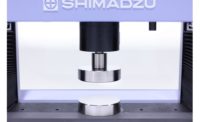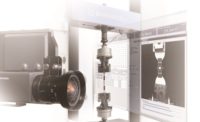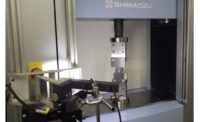Back to Basics: Flexural Testing for Plastics
A look at flexural test methods and ASTM D790

Flexural strength testing has become increasingly important for plastics—especially composite and carbon fiber-reinforced plastics—as structural parts in the aerospace industry are made from these newer materials.
Even for non-structural plastic parts used in electrical insulating materials, printed circuit boards and other products, flexural testing is important to determine support loads and to prove that rigid plastics can withstand deformation without flexing or bending. It’s key to understand the highest flexural stress these materials can experience in order to manufacture durable goods and materials.
Standards
ISO, JIS and ASTM have developed standards for flexural testing plastics, but for the purpose of this article, we’ll focus on ASTM D790.
It requires a test force accuracy that meets ASTM E4 Class 1, and accuracy within ±1% of the indicated test force. The standard specifies that tests can be conducted in one of two ways, measuring the crosshead position of the testing machine being used, or by using a deflectometer.
Using the crosshead position is generally for quality control purposes, where obtaining a close approximation of a value is all that’s needed, according to ASTM International Fellow Harry Yohn. For more accurate results, especially for engineering design purposes, a deflectometer is required.
How Does a Basic Flexural Test Work?
A rectangular cross section of the desired testing specimen is rested on two supports, and a force is applied by a loading nose midway between the supports.
“A support span-to-depth ratio of 16:1 is used unless there is reason to suspect that a larger span-to-depth ratio may be required, as may be the case for certain laminated materials,” according to ASTM information provided by Shimadzu. “The specimen is deflected until rupture occurs in the outer surface of the test specimen or until a maximum strain of 5% is reached, whichever occurs first.
“Flexural properties may vary with specimen depth, temperature, atmospheric conditions, and the difference in rate of straining.”
For the most precise results, a deflectometer, or deflection gauge, measures the amount of flexural displacement of a material when a load is applied.
It’s essential that properly calibrated test frames are used that can be operated at constant rates of crosshead motion over the range indicated, according to Shimadzu, and the load cells used are compliant with the test force accuracy required by D790. Lastly, having a variety of three-point bend testing fixtures allows laboratories to test a variety of specimens.
Deflectometers are more accurate that measuring the crosshead, because a crosshead measurement can be influenced by any give or movement throughout the entire machine, according to Yohn.
“A deflectometer contacts with a specimen during a test and measures the actual deflection that the specimen sees, and only that,” he explains. “You don’t have to worry about machine movement, fixture movement, or any other kind of movement. It measures what goes on at the specimen level.”
Plastics makers will use the test results to generate a data sheet including the ASTM test standards to provide buyers with the material’s physical properties.
“So, somebody who is looking to buy that material will say, “OK, it has ‘x’ value for flex test, so I’ll buy it,” Yohn says. “And then when I get the material shipped to me, I also want to test samples to make sure I’m getting the right stuff.
Challenges Posed by Reinforced and Composite Plastics
The same testing process applies to both reinforced and non-reinforced materials, and ASTM methods don’t distinguish the procedures between them, according to Shimadzu. However, per ASTM, “any test specimen preparation, conditioning, dimensions, or testing parameters, or combination thereof, covered in the ASTM material specification shall take precedence over those mentioned in these test methods.”
ASTM D790 also does not apply to all reinforced plastics; for reinforced plastics with certain properties, other standards apply, according to Shimadzu.
“In general, great care must be given to composite materials that combine different materials to achieve greater specific strength than is available from a single material,” according to information from Shimadzu. “Fiber-reinforced plastics (FRP) are typical composite materials. Carbon-fiber-reinforced plastics (CFRP) combine plastics with carbon fibers having high specific modulus of elasticity and specific strength.
“Because these are new materials, the evaluation of fundamental mechanical properties is essential, and significant R&D time is being conducted to ensure the stability of material quality and enhance reliability.”
Yohn adds that test repeatability with new materials, especially those made by additive manufacturing, can cause testing hiccups.
“When I talk to people who run these tests, particularly commercial testing labs, they are getting repeatable values. But whether or not they’re reproducible from one lab to the next, that’s going to be another story,” he explains. “And that’s what lot of people are looking at right now.”
Looking for a reprint of this article?
From high-res PDFs to custom plaques, order your copy today!






